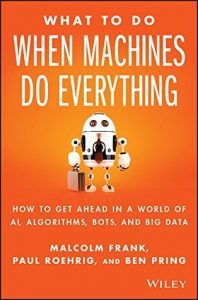A Quick Guide to Coexisting with the Future of Tech
Display Transcript
AI already impacts all of us; it’s in our phones, the planes we fly in, the way we bank, and what movie we decide to watch on a Sunday evening. Soon enough, these same AI will educate the young, heal the elderly, save money on bills, and catch criminals. They will usher in the fourth industrial revolution where those who know how to harness the power of the new machine will be able to reap the benefits of economic expansion. With the digital era upon us, it is no longer a question of what will machines do. For the most part, machines will be able to do everything decades down the road. For those interested in their future, the question now becomes, “What am I going to do?”
To answer that question, an excellent aide with an even more apt title “What To Do When Machines Do Everything” is a book written by Malcolm Frank, Paul Roehrig, and Ben Pring. As the leaders of Cognizant’s Center for the Future of Work, their job is to keep track of the evolution of technology and discover what the future of work will look like. Written in 2017, they spent the three year prior conversing with the world’s top minds from companies and universities in order to make greater sense of the imminent technological change that we are amid. This book delves into the statistics and analyzes the great shifts of the past to show how technology will change the opportunities we have, create new threats while eradicating old ones, and to show how man and machine will coexist.
Now, back to the question at hand. What will you do when machines do everything? For starters, we can check off the first box: that is to be aware that machines are doing more and more of the work we perform minute by minute. This is not to say though, that machines are going to replace every single job that they can. Rather, it’s important to look at these machines like a carpenter would look at a saw. It’s a tool that he / she can leverage to increase their efficiency. Reports out of oxford have estimated that nearly 45% of jobs would be eradicated by these machines, but the authors of this book take a much more reasonable approach: Only 12% of jobs are at risk of being fully taken over by systems of intelligence. Of the rest, 75% will be enhanced, as employment will remain, but the delivery will be of greater output and quality. 13% net new jobs will be created as a result of the new machines creating new revenue opportunities and/or new job categories.
The book is broken down into three main sections, the first being information about the machine: what it can and can’t do. The second is an evaluation of the industries it will be placed in and the places where it can be best utilized. The most important part of the book though, is the third and final part. The authors offer their roadmap to the future with a structured approach that they call the AHEAD model. The acronym stands for: Automate, Halo, Enhance, Abundance, and Discovery. To automate is to learn to outsource the computational work to the new machine, akin to the Netflix Blockbuster or Uber Taxi dispatching scenarios. Halo refers to an older book that the authors worked on call Code Halos. The breakdown is that every person has a virtual self and a physical self. The virtual self provides a plethora of data through their connected and online behaviors that the new machine can interpret and track. Using this data with the machine as an aide to organize it and sort the patterns, new customer experiences can be made, and business models can change that lead to overall economic expansion through integration with the customer. Think of it like how Amazon knows your literary taste better than your family might just based off your shopping patterns or Kindle behavior. Enhancement simply means to understand that the new machine is not an enemy, but rather a colleague who can help you increase your job productivity and satisfaction, similar to how the GPS in your car helps you drive by alerting you of road hazards, making sure you never get lost, and keeping you on the fastest route. Abundance points to the utilization of the new machine to open up vast new markets by dropping the price point of existing offers. Simple economics says that as prices goes down, demand goes up. Just as the loom led to more clothes and the steam engine created more transoceanic travel, the new machine will create abundance in several markets. The difference between inventions of the past and the new machine is that the past focused on physical goods. The new machine will create this abundance in knowledge based jobs such as education, financial services, healthcare, and everything in between. The last part of the model, Discovery, focuses on the entirely new products, services, and industries that the new machine will open doors to. Just as Edison’s light bulb led to advances in radios, televisions, and transistors, the new machine will usher in a completely new age of invention.
 What to do When Machines do Everything by authors Ben Pring, Malcolm Frank, and Paul Roehrig is a book about exactly what its title says. Written in 2017, the authors spent three years prior to publication conversing with the top minds from companies and universities in order to make greater sense of the imminent technological change. To summarize their findings, they offer their personal roadmap to the future with their acronym, AHEAD. Simply, the model says to outsource computational work to machinery, use virtual data already generated to stay ahead of the game, enhance your work by using technology as an aid, keep track of the market and the new jobs being created, and focus on the new products being developed.
What to do When Machines do Everything by authors Ben Pring, Malcolm Frank, and Paul Roehrig is a book about exactly what its title says. Written in 2017, the authors spent three years prior to publication conversing with the top minds from companies and universities in order to make greater sense of the imminent technological change. To summarize their findings, they offer their personal roadmap to the future with their acronym, AHEAD. Simply, the model says to outsource computational work to machinery, use virtual data already generated to stay ahead of the game, enhance your work by using technology as an aid, keep track of the market and the new jobs being created, and focus on the new products being developed.
The book really struck home for me, as it takes a realistic view of the future and does a great job of leaving the reader with a sense of hope and passion rather than the usual gloom and doom approach that many articles seem to take when talking about automation and machines.

Scott Mosher
Member of Cohort 7 of the Lockheed Martin Leadership Institute
View Biography
Scott Mosher is a third-year student at Miami University pursuing a Bachelors in software engineering. After coming to Miami for mechanical engineering, Scott had the opportunity to talk with many individuals in the software field at all levels of experience. After spending time with code, he found his passion was in creating tools and automating machinery through advanced implementations of software. He plans on graduating in 2020. Scott is an active member of the Lockheed Martin Leadership Institute, a program that focuses on transformational leadership and where leaders help their students identify weaknesses, and then learn how to overcome those weaknesses as a group using leaders in industries to inspire change. Outside of academics, Scott is an active brother of the Sigma Phi Epsilon fraternity. Through the fraternity, Scott has had the chance to volunteer for various philanthropic activities that benefit many different organizations. These activities have furthered both his professional and social skills in positive manners that will benefit him in a career environment down the road.
In the Lockheed Martin Leadership Institute, students are currently underway learning about the process of digital transformation, as well as researching new technologies that will change how businesses operate and pave the way for small start-ups to become multi-million dollar conglomerates. The project is an incredible learning experience that Scott is grateful to participate in.
